Content
- 1 How to choose a site for planting?
- 2 The optimal size of the beds
- 3 How to do it?
- 4 Covering materials for strawberry beds
- 5 Principles and Benefits
- 6 Material selection
- 7 How to prepare a site?
- 8 Planting strawberries
- 9 Strawberry care
- 10 Step 1. Choosing a covering material for strawberries
- 11 Step 2. Choosing a place for strawberry beds
- 12 Step 3. Prepare a bed for planting strawberry seedlings
- 13 Step 4. We form strawberry beds and organize drip irrigation
- 14 Step 5. We plant strawberry seedlings in the garden
- 15 Step 6. Taking care of the strawberries
- 16 Ideal bed parameters and general planting rules
- 17 Tall strawberry bed
- 18 Warm strawberry bed filled with organic matter
- 19 Vertical bed from the pipe: closer to the sun
- 20 Interesting options for do-it-yourself strawberry beds
Strawberry beds can be found in almost every plot, but not all of them can boast of abundant fruiting. When planting these wonderful berry bushes, you should adhere to special agricultural techniques, starting with the choice of beds and ending with the proper care of the seedlings.
The correct organization of plantings will help reduce the likelihood of strawberry diseases, damage by pests, and freezing in winter. Below we will look at how to make strawberry beds with our own hands, what type of beds to prefer, what materials are better to use.
How to choose a site for planting?
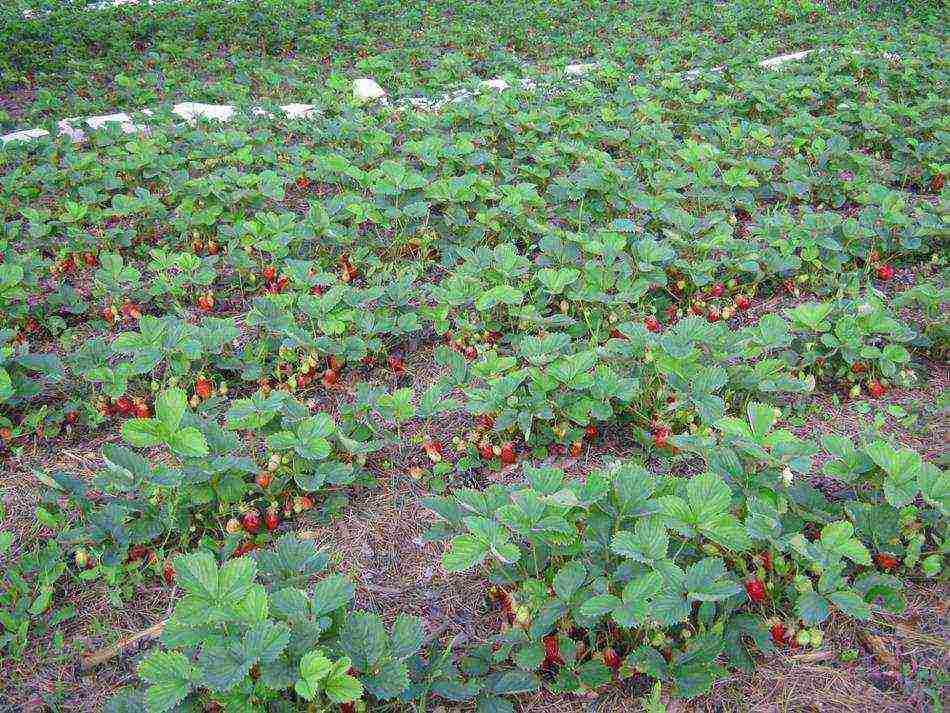
It is recommended to choose a plot for strawberries taking into account several important requirements:
- Strawberries are plants that love sunlight, so it is advisable to plant them in well-lit places. In this case, she will pick up a sufficient amount of sugar. When planted in the shade, the fruits will not be as sweet, but they will have more flavor. It is better to orient the beds from east to west for better illumination and uniform heating by the sun.
- The site should not be located in lowlands, near the surface occurrence of groundwater. The ideal location is on a hill.
- It is also important which crops grew earlier in the chosen place. The best precursors for strawberries are legumes, herbs, celery, radishes, corn, lettuce. Do not plant berries after tomatoes, cucumbers, eggplants, cabbage, peppers, raspberries, roses, blackberries. These plants have the same pests with strawberries, and are also susceptible to the same diseases.
- The proximity with other plants also affects the well-being of strawberries. It is negatively influenced by wild rose, roses, bird cherry, apple, plum, apricot, cherry. In general, it is not worth planting strawberries under the trees, since, in addition to the shade, it will suffer from spraying with pesticides.
- The best soil for planting is sandy or sandy-loamy, well fertilized.
You should know! The strawberry patch should be changed every 4 years. During this period of time, the plants take all the elements useful for themselves from the soil. Further, the berries begin to shrink, the bushes get sick, the yield decreases.
The optimal size of the beds
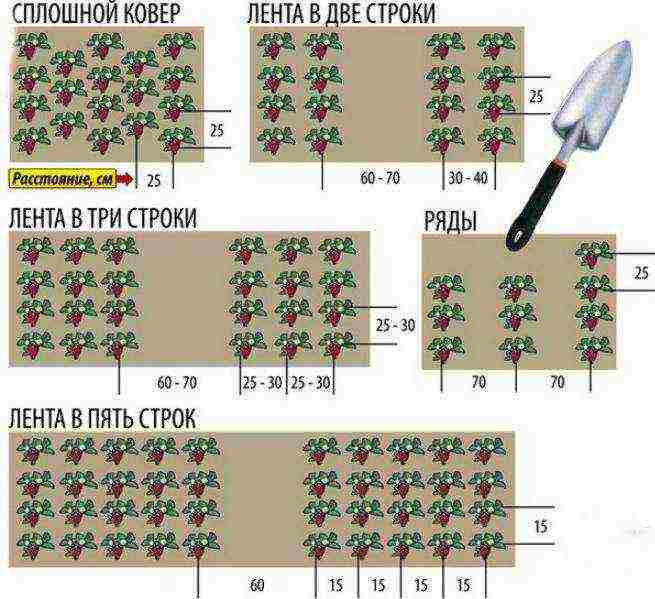 Planting options for strawberries
Planting options for strawberries
The most popular way of planting strawberries among summer residents is carpet. The bushes are independently distributed, settling in free areas.Gradually, the soil is covered with a layer of mulch that retains moisture. Maintenance of such a plantation is minimal. The disadvantage is that the berries gradually become smaller due to the thickening of the plantings.
In order for the berries to be large, it is recommended to adhere to some rules for planting bushes:
- A properly equipped garden bed should be up to 80 cm wide.On it you can plant 2 rows of plants with a distance of 40 cm between rows.
- Also, you can lay single-row beds 20 cm wide, between which there will be furrows 30-40 cm wide.
- The length of the bed can be any.
- The height depends on the type of bed. If the plants are planted out of the blue, then it is advisable to make furrows between the rows, which will be below the bookmark of the bushes. In such furrows, excess rainwater will collect, which negatively affects the roots and collects a lot of pests. These furrows will be easier to navigate when harvesting. The recommended furrow width is about 40 cm, the depth is 20 cm.
- The distance between adjacent bushes should not be too small, as strawberries do not like tightness. Optimally - 40 cm.
How to do it?
There are several ways to create strawberry beds. The simplest carpet method does not allow for the maximum efficiency of plantings, so it is usually improved. Consider all the most popular options, their features and arrangement.
German low
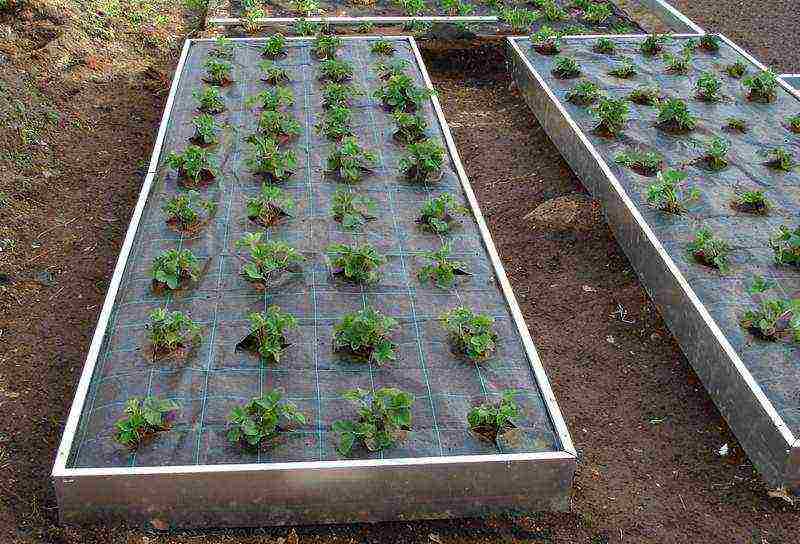
The width of the bed should be between 40-80 cm, depending on whether 1 or 2 rows of plants are planted. This method requires an enclosing box. Plantings are located at the soil level or slightly higher.
Manufacturing procedure:
- The marking of the future bed is being made.
- The selected place is cleared of weeds and debris.
- A box is being made. If slate, metal strips or other materials are used as fences, they will be installed later.
- From the surface of the soil, at the place of marking, the top layer is removed to a depth of about 40 cm.
- The bottom of the pit is filled with any organic matter. Branches, corn stalks, plant tops, grass, paper will do.
- The top layer of fertile soil is filled up with humus, rotted manure, decomposed compost. The soil is leveled and strawberries are planted.
Advantages:
- These smart beds provide easy maintenance.
- When watering, the soil is not eroded thanks to the fences.
- Plants are better protected from pests and diseases.
- The high content of organic matter in the soil will allow you to get a good harvest. Strawberries in such a bed will not need additional fertilizers.
Flaws:
- Labor intensity of the process.
- Material consumption for the fence.
Vertical
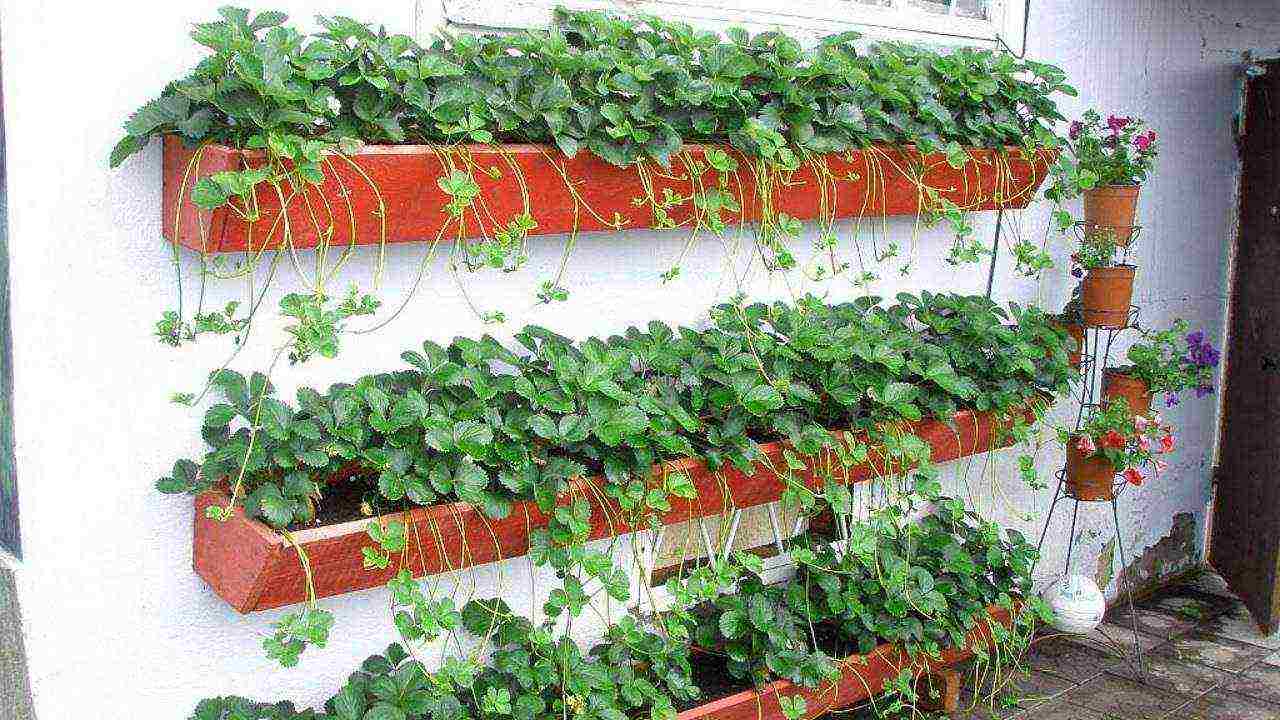
It often happens that there is not enough space in the garden for planting strawberries. In this case, you can build vertical beds by placing them in any free area of the yard. They can be attached to the walls of buildings or be independent structures.
The advantages of vertical positioning:
- They take up a minimum of space.
- You can even place it on your balcony.
- It is convenient to look after them.
- Good drainage. All excess water flows down.
- Bushes are located far from the soil surface, which reduces the risk of disease.
- Such structures are very beautiful, they are elements of landscape design.
- There is no thickening, as the bushes grow separately.
Flaws:
- Regular feeding and frequent watering are required.
- Plant roots can freeze in winter.
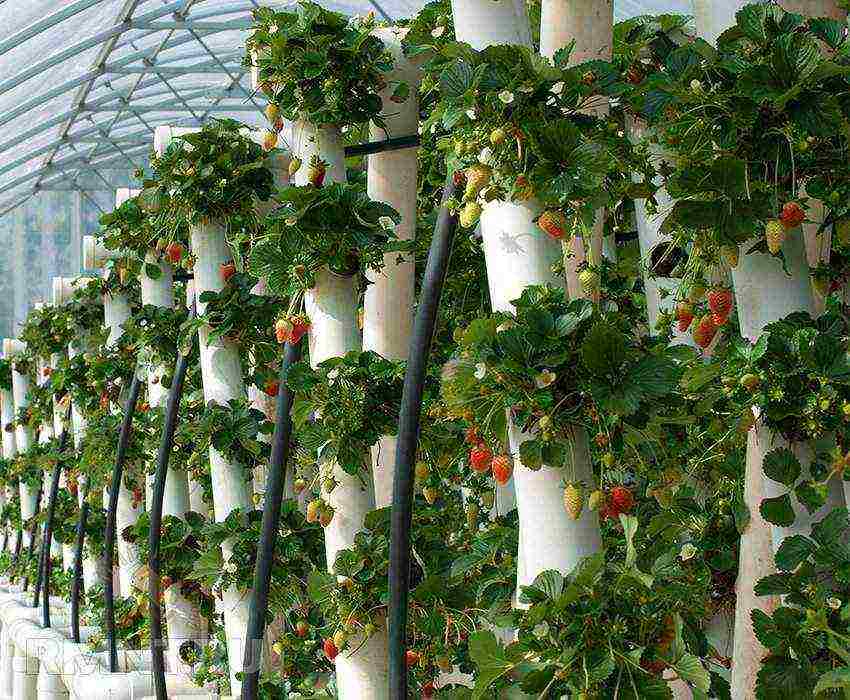 Vertical pipe beds
Vertical pipe beds
Creation of vertical beds from various materials:
- Made of PVC pipe. Two pipes of different cross-sections are used: 120 and 20 mm. The first tube serves as a frame. Holes with a diameter of 10-12 cm are cut in it, into which the bushes will sit. The distance between the holes is at least 30 cm. The pipe with a diameter of 20 mm is used for watering strawberries.Small holes are drilled in it for water to escape, after which the pipe is wrapped in burlap and inserted into the wide pipe. The wide pipe is then filled with fertilized soil. Bushes are planted in the holes.
- From car tires. Tires of different diameters are used. In each of them, you need to cut out a side shelf. The largest tire is placed in the designated spot and filled with fertilized soil. A tire of a smaller diameter fits on it. And so several tiers are filled. Bushes are planted along the perimeter of the tires, in each of them.
- From hanging bags. Soil is poured into old sugar bags, and several cuts are made in the walls of the bags. Bushes are planted in the sections. It is better to hang the bags from the walls of the building. Watering is carried out through the top neck of the bag. Ideal soil moisture is ensured, as excess moisture flows from the bag onto the ground.
- Multi-storey. They are pyramids, mostly wooden. A lower box of a square or triangular shape is being built, which is filled with organic matter and fertilized soil. The next box of smaller diameter is installed on it. This is how several tiers are exposed. Plants are planted along the perimeter of each of the tiers.
Warm
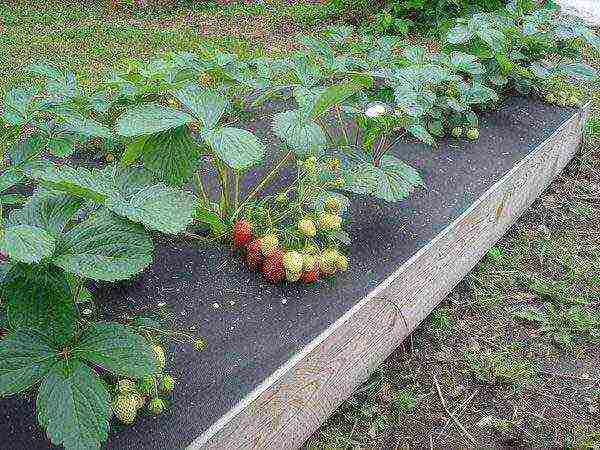 Frame warm strawberry bed
Frame warm strawberry bed
The principle of operation of a warm bed is simple. Rotting organic waste produces heat and methane, which is beneficial for the growth of strawberry bushes. A warm bed consists of several layers: plant drainage, an organic heat-generating layer and an upper fertile soil layer.
The advantages of warm beds:
- Plants receive a sufficient amount of heat, so they start bearing fruit earlier and bear fruit longer.
- Strawberry roots are fully nourished.
- There is no need to apply fertilizers during the season.
- Strawberries do not freeze in winter.
Flaws:
- It takes a lot of effort to arrange the "puff pie".
- For frame and combination type, consumables will be required.
The design of warm beds may vary. Let's list the features and ways to create them.
Wireframe
On the surface of the soil, a box of slate, corrugated board, boards or other materials is equipped. A heat-generating layer is formed in the box. Such beds work well in lowlands, on swampy and flooded soils.
Bulk
To create them, you need to dig a shallow trench into which all the layers characteristic of warm beds are laid. It turns out a small elevation on which strawberries are planted. This is the most popular option used by most summer residents. It is used in areas where there is no threat of flooding.
Combined
They combine both of the above options. The laying of the lower layers takes place in the trench, and the upper layers - in the erected box. This is the most time consuming method, but also the most effective.
Filling warm beds
All types of warm beds have the same structure:
- The lower part consists of branches that serve as drainage.
- Grass, leaves, compost, sawdust, rotted manure, etc. are placed on the branches.
- The contents of the garden bed are thoroughly rammed and then watered with hot or warm water.
- Fertile soil is poured from above.
- Strawberries are planted.
High

The peculiarity of such structures is the presence of high frames. If the site is located in a lowland, then it is often possible to grow a decent strawberry harvest on it only in this way.
Advantages:
- Plants will not be affected by groundwater.
- Convenience of care and harvesting. You don't have to squat or bend over to the ground.
- Comfortable paths can be laid between the individual boxes.
- The principle of warm beds works. The organic matter laid at the bottom of the box gradually decomposes, fertilizes and warms the bushes.
- Tall beds protect strawberries from crawling pests and most diseases.
Flaws:
- Regular watering is very important, since moisture does not come from below, and good drainage does not allow it to linger at the roots.
- The designs require serious preparation and considerable effort.
Arrangement procedure:
- Choose a place, make markings and clear the area of debris.
- Build a box from the material at hand. The height of the box can vary from 30 to 90 cm.
- Remove the top layer of soil.
- Fill the trench with organic waste (branches, grass, straw, leaves, sawdust.
- Make the top backfill from the removed soil by adding compost or two-year manure to it. The backfill should not reach the very top of the box. Leave a few centimeters.
- Plant the strawberries in rows.
Mobile
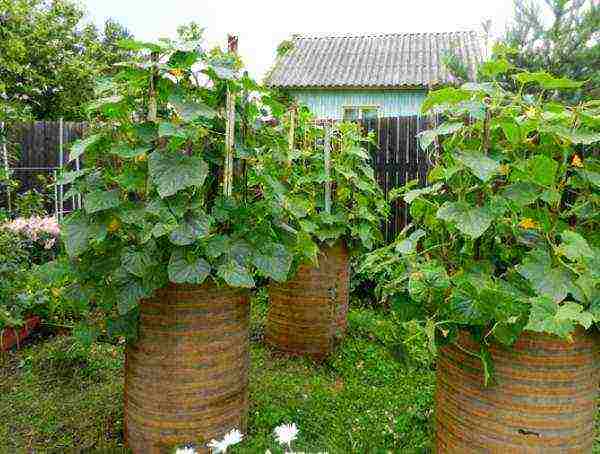
Interesting options for beds can be obtained from simple things that stand idle on the site. Plus, they can be moved from place to place. Mobile flower beds can be obtained from buckets, baths, barrels, boxes, and other containers. They are filled with soil mixed with organic matter, and then one to several strawberry bushes are planted.
Collapsible frames made of galvanized steel are popular, which, if necessary, are quickly dismantled and removed for the winter.
Advantages of mobile beds:
- The ability to transfer to any place.
- Low labor costs for manufacturing.
- Good warming up in the sun.
- Convenience of care and harvesting.
- Economical water consumption.
Flaws:
- In winter, there is a possibility of freezing of plants. Especially in metal containers.
- Regular watering is required due to the rapid loss of moisture.
From planks
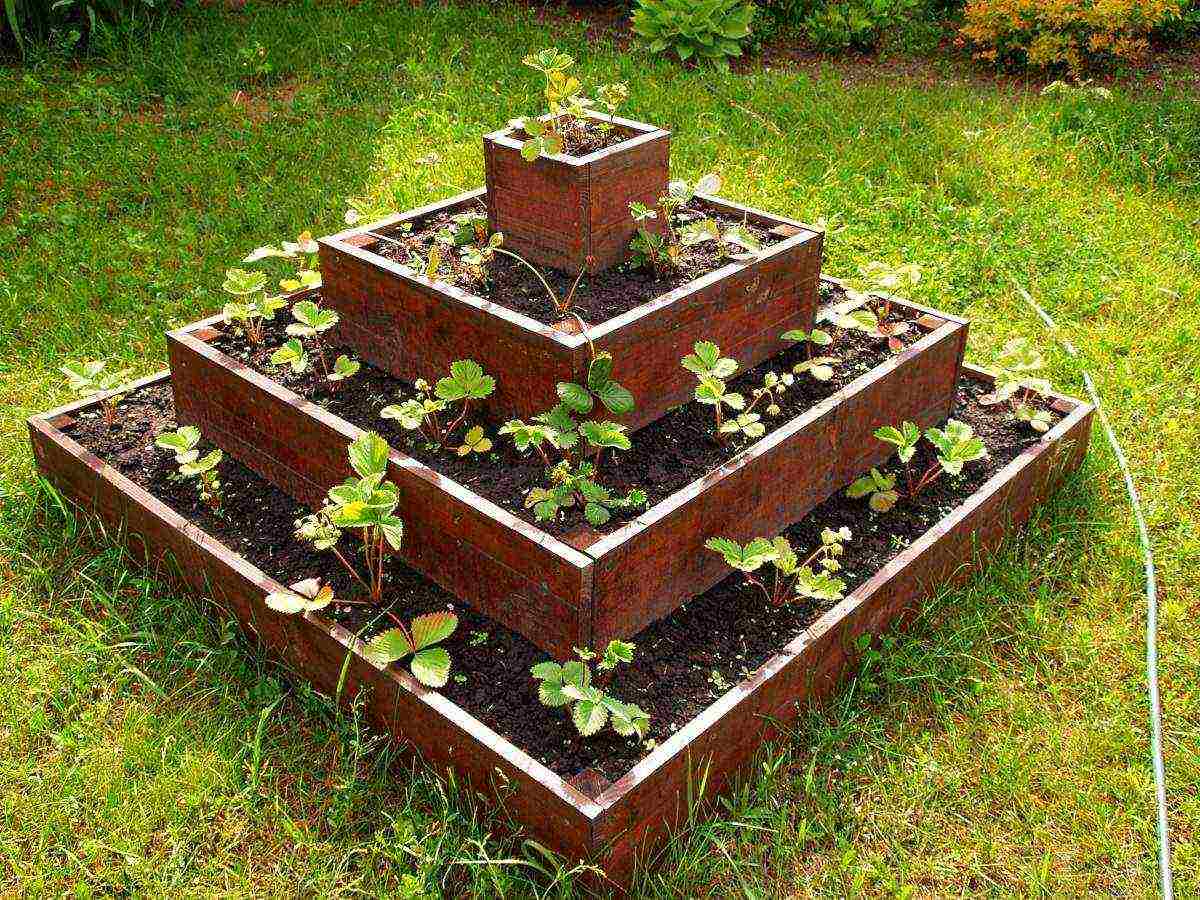
Planks are one of the most suitable materials for creating beds. Wood species that are resistant to decay are best in contact with the soil: oak, larch, beech, ash.
Advantages:
- A mild microclimate is created inside the beds, favorable for the growth of strawberries.
- On such raised beds, the bushes will hurt less and be affected by pests.
- The tree retains heat well, so the seedlings will be comfortable on cold days. The wood does not heat up in the sun, which is good for strawberries in the heat.
Flaws:
- The complexity of the creation process.
- The need to use power tools and fasteners.
- Some types of wood need to be treated with impregnations to prevent decay.
Construction order:
- A box is made of boards. The boards are fastened together with self-tapping screws.
- At the place where the box is installed, the top layer of soil is removed.
- Geotextiles are laid at the bottom of the box and drainage from crushed stone or small stones is filled up.
- On top of the drainage, fertile soil is poured into which strawberries are planted.
Slate

Construction slate is one of the available materials, therefore it is deservedly popular with gardeners. Beds made of flat or corrugated slate can be found everywhere.
Advantages:
- Fast and easy construction.
- Durability. Slate does not rot or decompose in the soil.
Flaws:
- Slate contains asbestos cement, which can adversely affect the composition of the soil.
- It is necessary to bury the sheets in the soil and additionally strengthen them.
Arrangement procedure:
- In the place where the garden bed is created, you need to remove the top soil layer.
- Slate sheets are buried into the soil by 10-20 cm.
- The corners of the beds are reinforced with metal corners to increase the strength of the frame.
- Pegs are driven along the perimeter of the frame to protect it from the wind.
- The frame is filled with potting soil.
Alternatively, you can first assemble a metal or wood frame and then attach the slate to it.
From tires
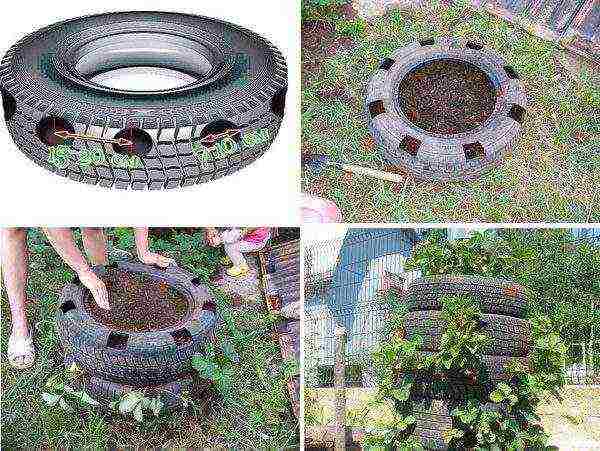
An old car tire may well serve as a flower bed.
Advantages:
- Free consumables.
- Takes up little space.
- Simplicity of arrangement.
- Reliable protection against winter frost.
- Original appearance.
Flaws:
- It is believed that rubber can release harmful substances into the soil, although this statement is controversial.
- It will take time and effort to cut the holes.
Making a flower bed:
- Holes with a diameter of about 10 cm are cut in the tire every 20 cm. Or the entire shelf is cut out.
- The tire fits in the right place.
- The bottom of the tire is covered with a net on which the earth is covered.
Covering materials for strawberry beds
To prevent drying out of the soil, control weeds and protect against frost, strawberry beds are covered with covering material. Both organic materials (sawdust, straw, leaves, needles) and inorganic materials (lutrasil, agryl, spunbond, agrotex, agrospan) are used.
Organic mulch requires constant renewal, while nonwovens are reused. Fungi do not multiply under a black shelter, weeds are suppressed, and the soil warms up faster. In beds with covering material, the berries are always clean, since they do not come into contact with the soil.
Working with agrofibre:
- The material is spread when transplanting strawberries into prepared beds.
- In the shelter, cross-shaped cuts are made according to the landing pattern.
- Bushes are planted in the slot.
- If the strawberry has already been planted, a shelter is spread over it, the bushes are groped and cuts are made.
- Agrofibre is fixed with pegs or sprinkled with earth.
With the correct construction of the beds, strawberries will certainly delight their owners with a regular and bountiful harvest.
Strawberries are a rather capricious and whimsical berry to care for, so growing it is not an easy task. This is especially true for regions with a cold climate, where it is much more difficult to get a good result than in the warm south. Finland is among the countries that have been particularly successful in growing strawberries. Finnish agronomists have invented a unique technology that greatly simplifies the life of farmers, as well as allows you to get a large harvest of large, fragrant berries.
Finnish strawberries
Principles and Benefits
As mentioned above, from a geographical point of view, Finland is not a suitable place for cultivating strawberries. But, despite this, it is the leader in the production of this berry - according to statistics, the annual harvest is 7-12 tons per hectare.
Growing strawberries using Finnish technology
The main secret of this result lies in the technology of growing strawberries using special materials (mulch coating), which accelerate the ripening of berries and improve their taste. The technique, which has already been christened Finnish all over the world, has a number of important advantages:
- nitrate nitrogen accumulates in the upper layers of the soil, due to which the nutrient environment of plants is significantly improved;
- mulch coating provides uniform heating of the soil and an optimal level of moisture, and also creates an obstacle to the growth of weeds and rooting of rosettes;
- microorganisms that live in the earth and contribute to the good growth of plants significantly increase their activity;
- the soil does not stain ripe berries, so they retain their presentation.
Mulching beds
You can grow strawberries in this way both in the open and in greenhouses, but in any case, it will take about 7-8 weeks for the berries to ripen.
Material selection
When growing strawberries using Finnish technology, a special black plastic wrap is usually used. In addition, in this case, a white film or non-woven polypropylene fabric such as Agrila or Agrotex can be used. Each material has its own advantages and disadvantages that should be considered when choosing.
Strawberry bushes under a black film
So, the use of a film requires the organization of a drip irrigation system, since water rolls down along it in the aisle. Insects and slugs settle in large numbers under the shelter, and during heavy rains, there is the possibility of mold.It should also be noted that the black material attracts the sun's rays, and in hot weather the plants need additional mulching with hay or cut grass. You can avoid overheating the earth by means of a transparent or white film, but in this case, along with strawberries, weeds will flourish on the plantings, which will need to be dealt with with herbicides.
Another disadvantage of the film is that even with low frosts, condensation forms on it, which is why it needs to be additionally heated. To do this, it is best to use sawdust, which must be covered with a layer of at least 8 cm.
Agrofiber
The use of agrofibre does not carry the risk of mold formation, since the fiber structure is able to "breathe". But at the same time, the surface of the soil dries up quickly, as a result of which the plants need to be watered much more often. Among the disadvantages of agrofibre is its rather high cost - the purchase of such material will cost more than the purchase of film.
How to prepare a site?
To grow strawberries, it is better to choose places well lit by the sun, away from trees and outbuildings. If plants are planted in the shade, they will often hurt, yield will decrease, and the berries will become small and sour. If we talk about the characteristics of the soil, then strawberries grow best on light and medium-sized soils with an acidity of 5-6.5. Planting is recommended to be done where legumes or grain crops grew, and land on which nothing has grown for 2-3 years is best suited. Strawberries should not be planted next to potatoes, peppers, or eggplants.
Strawberries grow well in sunny areas
It is best to start preparing the soil in the fall. Dry leaves are removed from its surface, after which the soil is well dug up to get rid of the roots of the weeds.
Preparing the beds
In the spring, after the earth has warmed up, it must be well loosened with a rake in order to break up large clods and saturate it with oxygen. Further, the soil should be fed, and experienced farmers recommend using organic fertilizers - for example, humus, compost or manure (5-6 kg per square meter), as well as mineral (35-45 g per square meter).
We apply fertilizer
After the land subsides (this takes about 7-10 days), the most crucial stage of strawberry cultivation begins - the arrangement of the beds. Low beds are poured on the site and their surface is well leveled with a rake.
The beds are leveled with a rake
The width of the beds should be approximately 80-90 cm, and the distance between the rows should be at least 65 cm, but they also do not need to be made too wide, otherwise access to the bushes will be difficult. For regular moistening of the planting, it should be equipped with a drip irrigation system, since it will be difficult to water the beds in a different way. A garden hose with a plugged end (its length must exactly match the length of the beds) is often pierced along its entire length, after which it is buried between the beds by 5-10 cm.
An example of equipped drip irrigation
Arrangement of beds
The next step is to prepare and lay the mulching material (agrofibre or film). It should be cut into pieces that exactly match the length and number of beds.
Agrofibre flooring
The film or agrofibre is rolled out to length, stretched well and laid on the surface of the beds. In this case, it is very important that there are no folds or creases on it, therefore, the material should be stretched very carefully so that it lies evenly and tightly. Along the edges, it is well fixed with boards, stones or special pins - you can make them yourself from wire.
Water bottles can be used as cargo
Next, you need to make markings on the surface, and then cut out cells (diameter 25-30 cm) every 30-40 cm.It is best to do this with a thin, sharp knife or a piece of metal pipe of the appropriate size in a checkerboard pattern so that the bushes do not interfere with each other.
Agrofibre with cells
Some farmers prefer not to cut round holes on agrofibre or film, but simply make cross-shaped cuts, but this cannot be called the optimal solution. The fact is that over time they will expand further, which can negatively affect the plants. To facilitate the task, you can buy material perforated in the factory from a specialized store.
The choice of agrofibre for growing strawberries
Arrangement of high beds
High beds of slate
Another popular way of growing strawberries in Finland is planting in tall beds. It is especially well suited for cold, humid regions where the soil does not warm up or ventilate properly. It is very simple to equip high beds with your own hands - for this you will need the simplest materials, best of all a fifty board. A box with a height of no more than 50 cm is hammered out of it, which will serve as a frame and will not allow the bed to sink.
Growing strawberries in high beds
Its length can be arbitrary, depending on how much strawberries you plan to grow. The box is installed in its proper place, after which they well dig up the earth inside it, choose the weeds and fill it up with fertile soil. Everything else, including the preparation and laying of the mulching material, is done in the same way as when arranging ordinary beds.
An example of tall wooden beds
Planting strawberries
For cultivation of strawberries according to Finnish technology, it is best to use seedlings in pots (they do not experience much stress when transplanting), but you can also use strawberry seedlings that were grown in the open field.
Strawberry seedlings
It will need to be prepared accordingly: a few hours before planting, shorten and soak in a solution of potassium permanganate or in a special rooting preparation.
It is best to plant young strawberries in cloudy weather or in the evening, so that the scorching sun rays do not destroy the seedlings. If the procedure is carried out in the morning, planting should be protected from the sun for several days so that the seedlings can acclimatize.
Video - Planting strawberries
In each hole made on the surface of the mulching material, use a small scoop to dig small holes, the depth of which will correspond to the length of the roots of the seedlings. Pour about half a liter of water into each of them and place a strawberry bush. After that, the soil under the plantings must be well moistened again, and mulched with peat or manure. The first watering of strawberries is carried out manually in each well, and then using a pre-equipped irrigation system.
Strawberry care
Strawberry care
Caring for a strawberry planting on film or agrofibre is no different from a similar process on ordinary beds. Plants will need to be fed with complex mineral fertilizers, cut off dried leaves and excess antennae, and spray them from the weevil. Strawberries planted in this way in June give their first berries in August, and due to the fact that they do not grow on the ground, they are very easy to pick.
Plant care
After the strawberry fruiting period is over, the mulching material should be removed, dried well and rolled into a roll until next year. From strawberry bushes, dried and diseased leaves should be removed, and then treated with a solution of potassium permanganate or drugs for diseases. After the onset of cold weather, the plants can be covered with straw, which will protect them from freezing.
Growing strawberries using Finnish technology only at first glance seems to be a difficult task.In fact, this is the perfect way to simplify planting maintenance, increase yields by at least 20%, and get a good harvest of beautiful, clean berries with great tasting qualities.
Video - Planting strawberries on film
Every summer resident would like to receive a rich strawberry harvest in the shortest possible time. And enterprising Finns are no exception. They had to invent the method of accelerated ripening of strawberries not from a good life: the summer in Finland is short and does not differ in warmth.
But the Finnish method is not only about keeping warm. Among its advantages is the ability to get a clean berry, without weeds. It is this cultivation technology that ensures the inaccessibility of the crop for pests, and also significantly reduces the likelihood of diseases in plants. Due to the fact that the top is placed on the covering material, the strawberry whiskers cannot take root. Well, the above method provides a minimum of labor and effort during weeding.
If a few years ago this method seemed exotic to novice summer residents, today, in principle, any gardener can grow strawberries using Finnish technology.
Step 1. Choosing a covering material for strawberries
The Finnish growing method is based on a simple rule: to preserve the heat, which is so necessary for the growth and ripening of strawberries. To do this, farmers plant seedlings on some kind of covering material - most often they choose black mulching film or agrofibre for strawberries (spunbond, lutrasil, agril, agrospan, etc.).
These materials differ not only in cost. Each of them has its own advantages and disadvantages. Therefore, choose the option that is most optimal for you.
| Mulch film | |
|
Advantages:
Flaws:
|
|
| Black agrofibre | |
|
Advantages:
Flaws:
|
|
Step 2. Choosing a place for strawberry beds
This should be an area with full sun all day. The future bed should be at a considerable distance from any buildings or trees - this way you can avoid shadows. In no case should this rule be ignored, otherwise you will get small sour berries instead of large sweet strawberries.
Step 3. Prepare a bed for planting strawberry seedlings
When growing strawberries, the soil is also of great importance (it should be neutral or slightly acidic). The best thing is to organize the beds where any legumes or crops grew a couple of years ago.
It is better to prepare soil for strawberries grown according to Finnish technology in autumn. At this time, garbage and dry leaves are removed from the site and the soil is dug up with the simultaneous application of fertilizers (about 10 kg of humus or compost, 30 g of superphosphate and 15 g of potassium chloride per 1 square meter). When spring comes, the soil is leveled with a rake, breaking up large clods of earth. This procedure helps to saturate the soil with oxygen, which is very important for plants.
Step 4. We form strawberry beds and organize drip irrigation
They begin to form strawberry beds 10-14 days after all the preparatory work has been completed. How long they will be depends on the area of the site. In order for the sun to warm up the soil as much as possible, the beds should be located from south to north. As for the width of the beds, it directly depends on how many rows you want to make.
According to Finnish technology, strawberry bushes in garden beds can be planted in one, two or three rows.
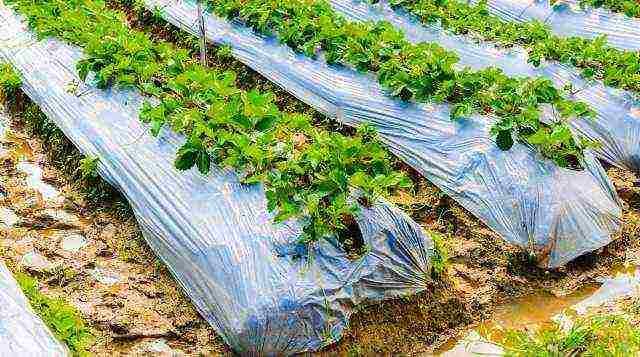
Single row planting of strawberries
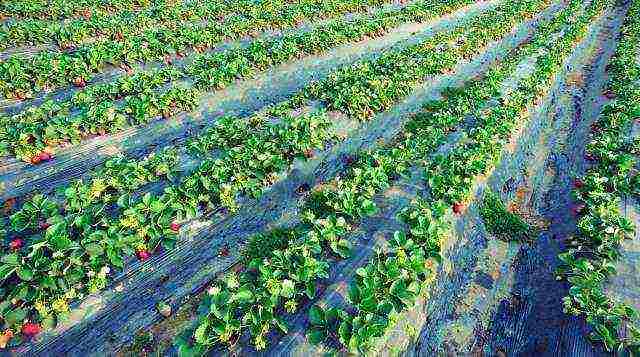
Double row planting of strawberries
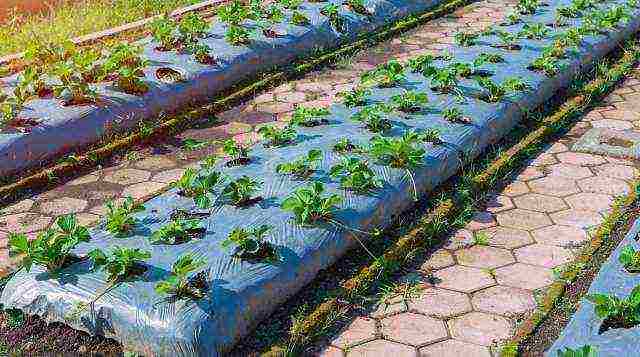
Three-row planting of strawberries
But the two-line method is considered the most convenient and rational. In order for the soil to warm up better, they form high (up to 40 cm) ridges with a width of 50-60 cm. In the center of them they lay a drip tape or a perforated hose for drip irrigation. The length of the hose should correspond to the length of the bed, one end should be connected to the garden hose, and the other should be closed with a plug.
Step 5. Planting strawberry seedlings in the garden
The formed beds are covered with a covering material, cut in accordance with the size of the beds. Each piece of material is stretched and laid tightly on the surface of the garden bed. All this must be done carefully to avoid creases. To prevent the covering material from flying away with the first wind, it must be securely fixed. For this, everything that is present in abundance at any dacha is suitable - boards, stones, bricks, etc.
Now, on the covered garden, you need to outline the places in which the strawberry bushes will be placed. To do this, cut holes with a diameter of 7-10 cm on the covering material.The distance between them in a row should be 25-30 cm, and between rows - 30-35 cm.
The best thing is to cut the holes in a checkerboard pattern. This arrangement will be very convenient for strawberry bushes - as they grow, they will not interfere with each other.
Some gardeners prefer not to cut circles in the covering material, but to cut it in the form of a cross. It is not advisable to do this, because over time these cuts will increase in size, which is why the material will not be able to fully fulfill two of its main functions - to retain moisture and prevent weed growth.
Once you've finished cutting the holes, you can start planting the strawberry bushes. To do this, use either mustaches rooted in the garden, or plants grown in containers and pots. By the way, the second option is preferable, such seedlings are considered more hardy and have a good chance of quickly adapting to new conditions.
Before planting, the roots of seedlings with an open root system are recommended to be kept for some time in a solution of any root formation stimulator (in accordance with the instructions).
When to plant strawberries in spring depends on the climatic zone, so pay attention to the long-term weather forecast. In the middle lane, strawberries are planted from early to mid-May. It is better to land when there is no bright sun - in cloudy weather or in the evening. The bushes must be planted very carefully so as not to damage their root system. The planting depth is the same as under normal conditions - the roots must be reliably hidden in the ground, and the growth point ("heart") must remain on the surface of the bed.
Step 6. Taking care of the strawberries
Taking care of Finnish-grown strawberries is not that difficult. Basically, this is the organization of high-quality timely watering, feeding, trimming the mustache.
Watering
Water the strawberries as needed. For this purpose, the water should not be warm, but also not icy. Strawberries are actively growing, and from the beginning of May to the end of September they need constant and frequent watering. In summer, if there is no heat, it should be watered once every three days. On hot days, water every day.
Treatments against diseases and pests
To prevent your strawberries from being attacked by pests and diseases, you need to take care of prevention. In early spring, against diseases, strawberries are treated with 1% Bordeaux liquid or any other preparation based on copper, and against pests, the bushes are sprayed with Aktellik, Teldor, Envidor, Calypso and other insecticides. Another preventive treatment is recommended after picking berries (the same preparations).
Top dressing
To make your strawberry happy with a good harvest, you need to feed it in a timely manner. Moreover, each season requires its own type of fertilizer.
As soon as the first green leaves appear on the outlets, you need to apply fertilizers that contain potassium or nitrogen. Many summer residents usually use a simple but effective mixture for young strawberry seedlings: 0.5 liters of manure or chicken droppings, 1 tbsp. ammonium sulfate is diluted in a bucket of water (about 10 liters) and the bushes are watered - at the rate of 1 liter of the mixture for each.
The second time the strawberries are fed after the first ovaries appear on them. As a rule, during this period, fertilizers are applied that contain potassium, nitrogen, calcium, phosphorus and other trace elements. You can feed the strawberries with this solution: 2 tbsp. nitrophoska and 1 tsp. potassium sulfate per 10 liters of water, or 2 tbsp. dilute potassium nitrate in 10 liters of water. You can prepare a top dressing from vermicompost: 1 glass of vermicompost is diluted in 10 liters of water and infused for a day, and then again diluted in half with water. Whatever top dressing you choose, you need to pour it in an amount of 0.5 liters under each bush.
In summer, potassium monophosphate is used as a top dressing in a proportion of 1 tbsp. 10 liters of water.
In autumn (early September and late October), strawberries need trace elements such as potassium, phosphorus and sodium. Many people use a 10 g solution of superphosphate per bucket of water. If you need to feed already cut bushes, use the following solution: add 2 tablespoons to a bucket of water. nitrophoska and 20 g of potassium salt. About 1 liter of the resulting solution is poured under each bush.
When using mineral fertilizers, strictly adhere to the proportions indicated in the instructions. Otherwise, you can burn the strawberry root system.
Finnish strawberry cultivation technology is not in vain popular with farmers around the world. If everything is done correctly, then the harvest of large juicy berries can be obtained in record time! Moreover, the method is not as complicated as it seems at first glance.
Do you use Finnish technology? Write in the comments!
 Traditional Russian beds on a flat surface or on an earthen ridge for garden strawberries have significant drawbacks that gardeners no longer want to put up with.
Traditional Russian beds on a flat surface or on an earthen ridge for garden strawberries have significant drawbacks that gardeners no longer want to put up with.
You can often come across the statement that strawberries are a finicky berry. This is not at all the case. It does not require frequent watering and feeding, it winters well, reproduces well and can grow in one place for a long time.
The content of the article:
- Ideal bed parameters and general planting rules
- Tall strawberry bed
- Warm strawberry bed filled with organic matter
- Vertical bed from the pipe: closer to the sun
- Interesting options for do-it-yourself strawberry beds
- - A bed of plastic bottles
- - Horizontal bed made of PVC pipes
- - A bed of old car tires
- - Strawberries in hanging bags
- - Wooden strawberry pyramids
- - Garden bed made of blocks
All that strawberries need for a high and healthy harvest: oxygen access to the roots without waterlogging, good air circulation in the growth zone of the bushes, an illuminated area, fertile soil and no contact between berries and soil. The correct arrangement of the garden will help to create all these conditions.
Ideal bed parameters and general planting rules
With good agricultural technology, the strawberry plantation lasts up to 5 years. Then the soil accumulates pathogens, is depleted, old bushes bear fruit worse. A site change or soil replacement and plant renewal is required.
Planting stock can be purchased at a gardening store, or you can use the strawberry's natural tendency to blow a whisker to take over new territory. If you take seedlings from your site, then you need to be sure that there are no nematodes and strawberry mites. Disinfection from pathogens is mandatory for both your own and purchased material.
Note! Repaired strawberries produce fewer whiskers, the aisles stay clean longer. If you plan to propagate your variety, then in the second half of summer, pick off flowers, loosen the aisles and conduct moderate watering.

Regardless of the type of bed, we note the parameters that are always taken into account to create an ideal microclimate:
- the width of the bed is 80 cm: the plants are planted in two rows with a row spacing of 40 cm, the bushes are well ventilated, the row spacing is convenient to weed and loosen, there is no difficulty in picking berries;
- the garden bed is oriented from east to west: uniform lighting throughout the day;
- the distance between plants in a row is 25-30 cm: remontant varieties form more powerful and taller bushes, therefore, the distance for them is increased to 30 cm;
- the optimal distance between individual beds is 65 cm: this is enough for the passage of a garden wheelbarrow in order to freely carry out gardening work;
- the height of the beds in different technologies is taken from 20 cm to 1 m, but even a slight rise is favorable for the development of culture;
- the soil between the beds is kept in turf (the growing grass is simply mown at the level of 5 cm): the black soil overheats, and the weeds serve as a breeding ground for pests and diseases, while the low-cut grass is pleasant to the eye and is useful for the garden;
- planting of seedlings is carried out under a black film (manufacturers supply it with already cut holes, according to the planting scheme): no weeds, the berry does not come into contact with the soil and remains clean even after rain, as a result the spread of gray rot is noticeably reduced;
- the neighborhood of strawberries with fruit trees is undesirable: in some years, strawberry bushes may suffer from attacks of leaf-eating caterpillars.
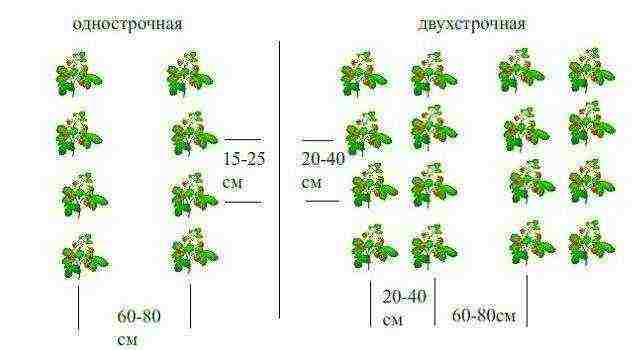
Landing scheme options
In the device of the garden, one must not forget about drainage and nutritious soil. Well filled with organic matter (compost, humus, peat) soil can provide a rich harvest for 3-4 years of cultivation without additional fertilizing. To prevent gray rot, the soil is spilled with Fitosporin solution before planting seedlings.
Tall strawberry bed
Fences can have a height of 20-40 or even 90-100 cm. The second option is more convenient in caring for plants and when harvesting, it is indispensable in swampy areas and with a close occurrence of groundwater with frequent spring flooding. But it also has negative aspects: the soil dries out faster, the plants experience overheating, in severe winters there is a high probability of freezing.
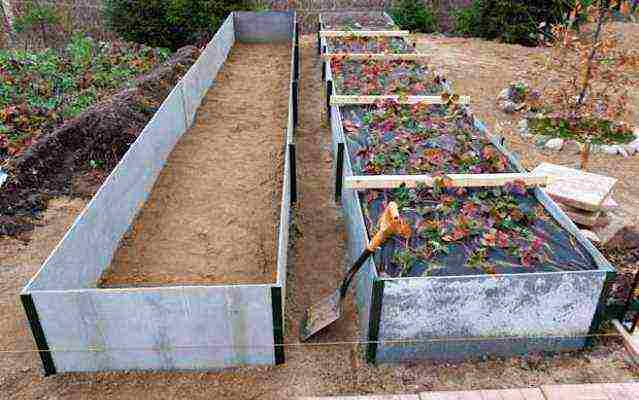
Here, it is necessary to use mulch or black film and winter shelter with spunbond or lutrasil in regions with frosty winters, as well as a drip irrigation device for uniform moistening.

For beds less than 40 cm, weather disasters are not so terrible, but to care for them you will have to bend over and sit down. A box for a garden bed can be made independently from boards, slate, bricks, or you can order ready-made galvanized beds.
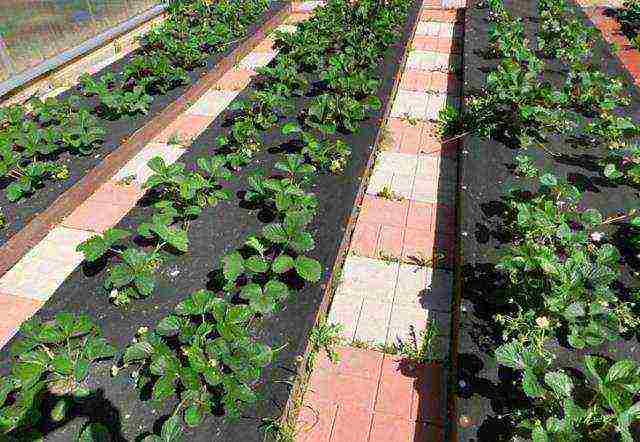
At the place of installation of the box, a layer of earth 10 cm thick is removed.Then a protective mesh from rodents or geotextiles is laid and the box is installed so that its walls are deepened by 10 cm.At the bottom of the bed, large branches and broken brick are laid out for drainage. At the last stage, the box is filled with nutritious soil from compost, garden soil and poultry droppings.
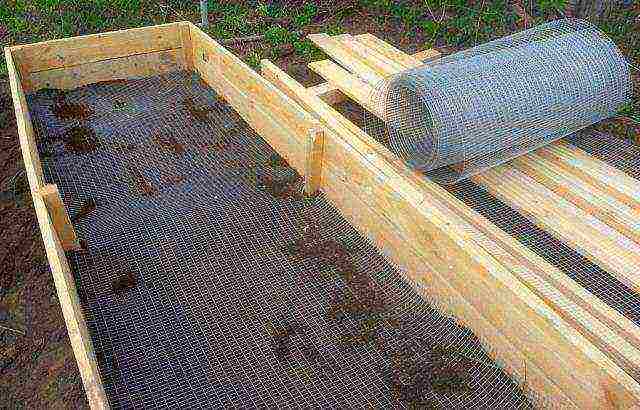
Attention! Do not take land in the beds after nightshades, cabbage and cucumber, as it can be infected with gray rot.
Warm strawberry bed filled with organic matter
The principle of a warm bed is the slow decomposition of organic material with the release of heat. Such a device is suitable for regions with cool summers and late return frosts. The filling of the bed is like a puff cake. The layers are the same as in the compost heap, only in the opposite order.
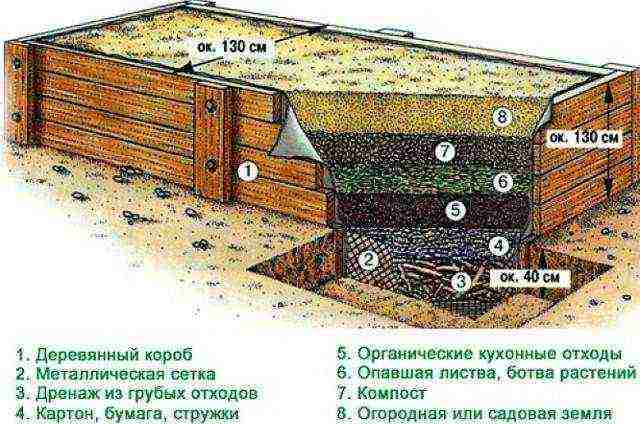
Large wood waste is placed on the bottom: wood chips, thick branches, chopped hemp. Next, pieces of cardboard are lined in several layers. Sawdust and shavings are poured on top, covering everything with a layer of freshly cut grass (great if there are crops of green manure) and chopped weeds (if you are preparing a garden in the summer, then make sure there are no seeds).
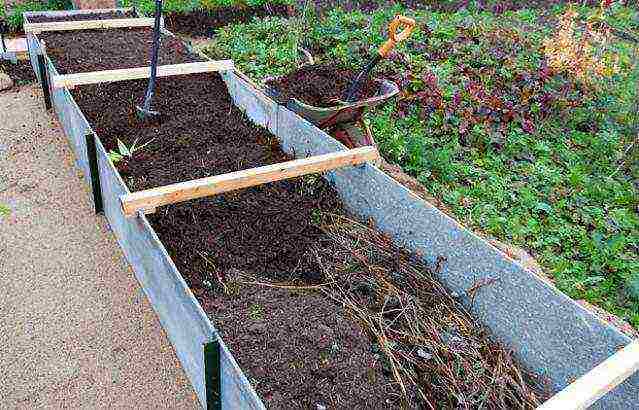
The last layer is matured humus or compost. The root system of strawberries is fibrous and highly branched. The bulk of the roots is in the 20-25 cm layer. This must be taken into account when determining the thickness of the fertile layer.
The average height of a warm bed is about 1 m. If you want to "lower" the fence, before installing and filling the box, dig a pit of the required depth.
Vertical bed from the pipe: closer to the sun
The idea of vertical beds tempts by saving space in the garden and decorativeness. This option is suitable for areas with any soil, and the garden bed itself can be placed right in the recreation area and enjoy the aroma and taste of ripening berries while lying in a hammock. Still, this technology is good for a humid and mild maritime climate, and not for the arid Volga region or the harsh Moscow region.
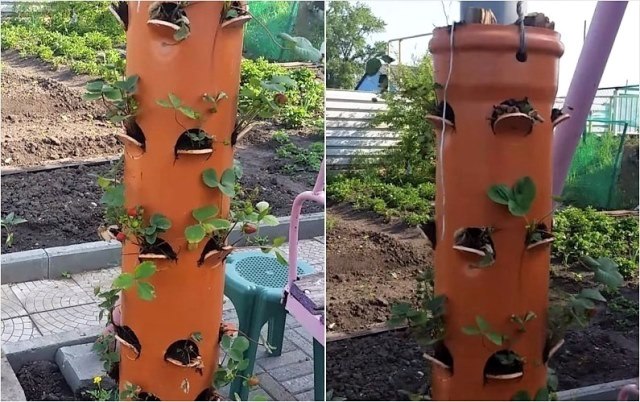
A small volume of potting soil dries quickly, therefore an integrated semi-automatic irrigation system is required. To increase the moisture content, a hydrogel is added to the substrate.
The process of making a vertical bed from a plastic pipe includes the following steps:
- cut holes with a diameter of 10 cm in a pipe of the required length;
- the first lower hole is located 80 cm from the edge (this part of the pipe will be buried in the soil)
- in the lower part we put a plug with drainage holes;
- an irrigation tube with holes wrapped in agrofibre or burlap, or a drip irrigation tape, is installed in the cylinder in the center;
- the pipe is filled with a substrate at the same time as planting seedlings;
- plants can overheat greatly, so it is advisable to cover the plantings with white spunbond.
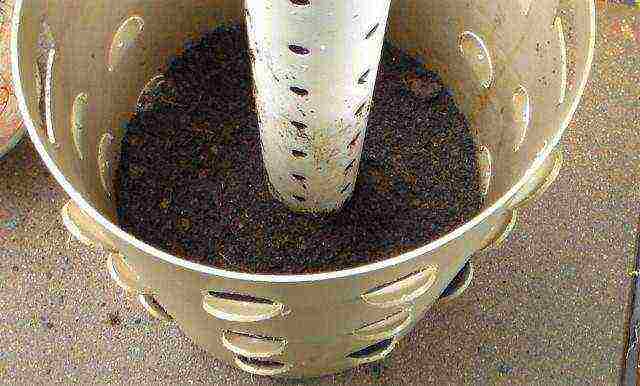
For the winter, vertical structures in Central Russia are either transferred to a horizontal position and thoroughly covered, or brought into a closed room.
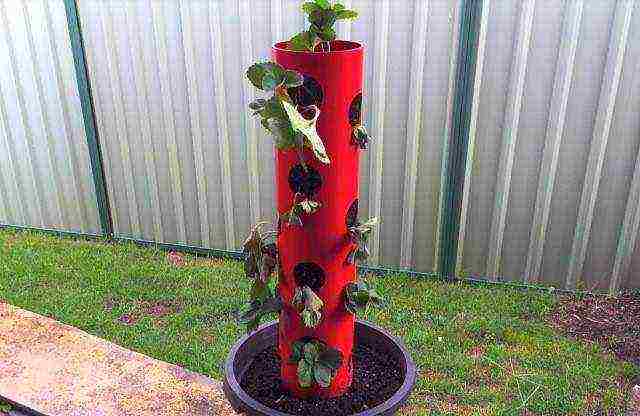
Another nuance of a vertical plantation: it is impossible to collect planting material from it for renewal of plantations. Therefore, to preserve the collection of varieties, we recommend leaving a few bushes in the traditional garden.
Interesting options for do-it-yourself strawberry beds
In this section, we will look at ideas for mobile beds that can be placed in any sunny part of the site. They can be made from cheap materials at hand. In order for the plants to develop and bear fruit, the structures are filled with a substrate enriched with organic matter. During the growing season, fertilizing with an ash solution, infusion of bird droppings or mineral fertilizers is mandatory. To increase the water-holding capacity, a hydrogel is added to the soil.
Even with proper care, mobile beds are short-lived. Full soil replacement every 2 years will allow keeping the yield at a high level.
A bed of plastic bottles
For the full development of a strawberry bush, a volume of at least 2 liters is required. Cut off the neck of the bottles, but do not throw it away. We will make a drainage device from it: remove the lid and lower the resulting funnel to the bottom of the bottle, wrapping it with a thick layer of burlap or agrofibre; at the bottom of the bottle, stepping back 5 cm, we make round holes for drainage and evaporation of excess moisture with a diameter of 5 cm.
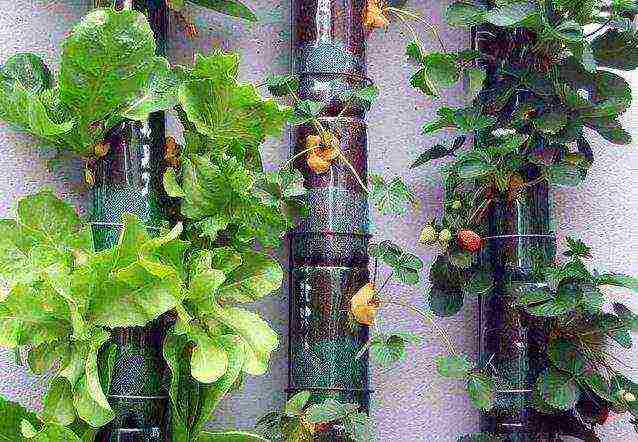
To ensure systemic irrigation in the bottom of each bottle, we make several holes through which water will flow from the upper bottle to the lower one. Do not make a bed too high, a chain of 4-5 bottles is enough.
We plant the seedlings in a hole with a diameter of 5-8 cm. Place the bottles on top of each other, securely fixing them with wire to the wooden frame.
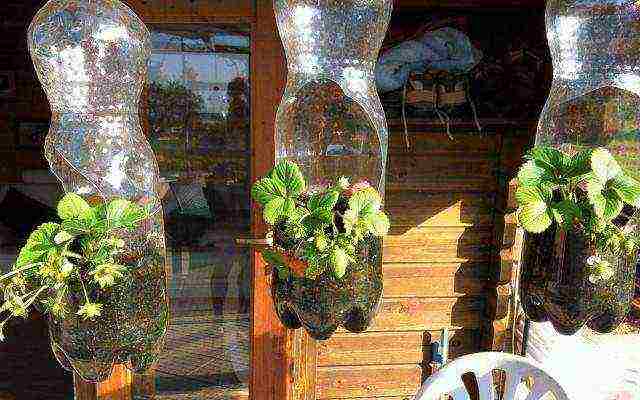
This option is well suited for creating a one-year ornamental garden. It can be placed near the playground so that children can feast on clean berries and do not spoil the main beds.
Horizontal bed made of PVC pipes
The essence of the idea is as follows: holes with a diameter of 10-15 cm are made in a large-diameter pipe at a distance of 15-20 cm from each other, filled with nutrient soil and installed on high supports. Drainage - small pebbles.
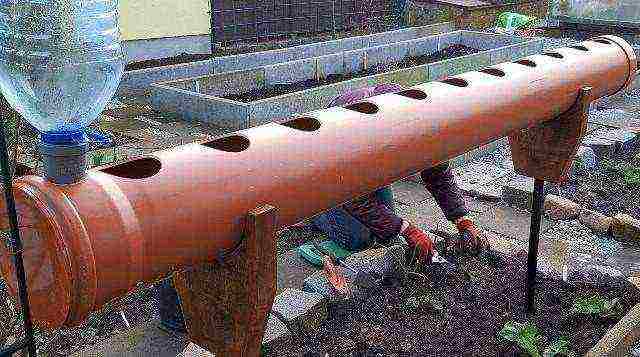
Watering is carried out through an inner pipe with a diameter of 40-50 mm with holes; for uniform distribution of water, the pipe is wrapped with a covering material. A more efficient but costly method is drip irrigation.
A bed of old car tires
Not the most environmentally friendly option, but actively used. You can create a column by stacking tires of the same diameter on top of each other. Or make a pyramid using tires of different diameters. Let's consider the first method, since it has some nuances.
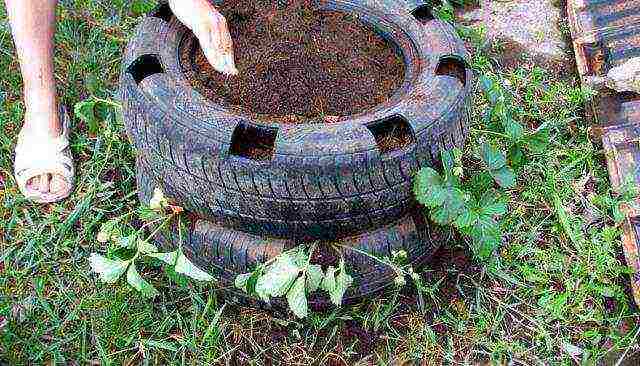
In the upper part, we cut out square holes 10x10 cm, we make an interval of 15 cm between the holes. We must not forget about the drainage. At the installation site of the bed-column, you need to dig a shallow 7-10 cm foundation pit and fill it with sand and gravel. In the lower part, in the circle of each tire, we make holes with a drill for water drainage.
To make the soil sufficiently loose and breathable, we add peat and perlite.
Strawberries in hanging bags
This is a great cultivation option for a balcony, terrace or gazebo. It should also be considered as an addition to stationary beds. Seedlings are planted in bags with pockets or in separate small bags. You can sew them yourself from thick fabric or buy ready-made ones at a gardening store.
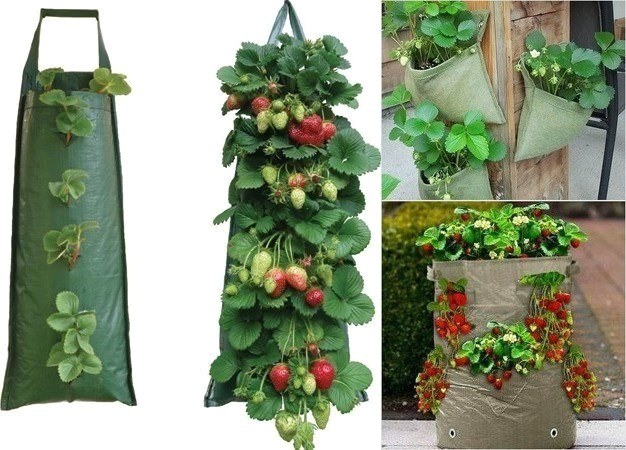
There is no need to think over drainage here, since the water itself will drain through the burlap. Plant care includes frequent and not abundant watering, top dressing and evening spraying of the leaves.
Wooden strawberry pyramids
Eco-friendly and durable beds can be made from wooden planks. First, several boxes with different perimeters are knocked down so that it turns out to assemble a pyramid.

Then the structure is covered with nutritious soil and the seedlings are planted. Low sheltered pyramids withstand Russian winters well.
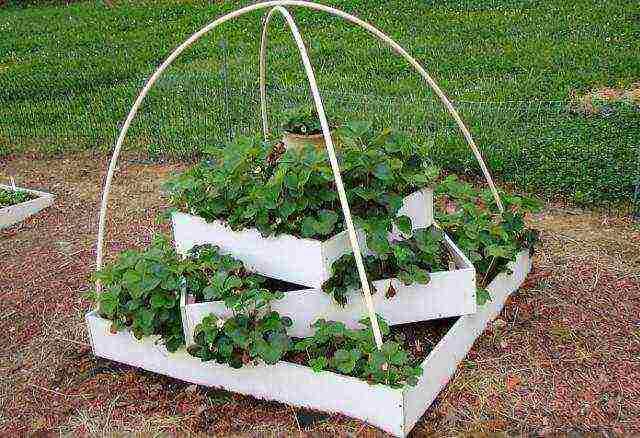
Garden bed made of blocks
Among the materials at hand in the country, there are very often various building blocks that can be perfectly used for organizing beds and flower beds. A hollow block offers more options than a standard solid or fence-only brick.
Like the elements of the constructor, such blocks are folded into various structures, and their voids are filled with strawberry bushes.



